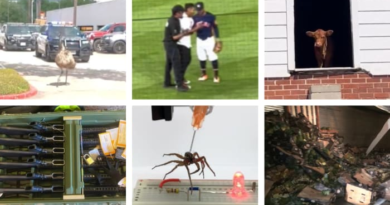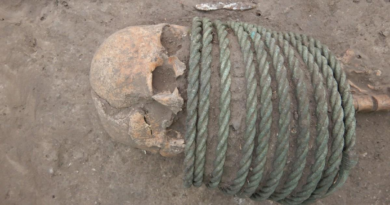'This is really weird. Who wakes up and their hand doesn't work?' – The Washington Post
Sign in
The act was so routine Michael Brenner never thought about it — until the Sunday morning in June 2021 when he ambled over to his computer to type a quick note and discovered he couldn’t. Brenner, who is right-handed, was unable to lift or extend his fingers, which felt inexplicably stiff. His left hand was unaffected.
“I thought, ‘This is really weird. Who wakes up and their hand doesn’t work?’ ” Brenner recalled.
A week later, his condition unchanged, the 29-year-old investment firm research analyst saw his internist for what he assumed was a minor, and easily fixable, problem. He soon discovered it was neither trivial nor easy to diagnose; he had no idea how tricky it would be to treat.
Over the next 10 months, Brenner would consult an orthopedic hand surgeon; a physiatrist, a medical doctor who specializes in physical rehabilitation; multiple neurologists; a neurosurgeon and a plastic surgeon in a circuitous, time-sensitive effort to fix his partially paralyzed hand.
In January two Baltimore surgeons — with the help of a New York expert who was looped into the operating room at the last minute via video call — performed microsurgery that appears to have been successful.
“I had become very open to the idea that I was never going to know what was wrong,” said Brenner, whose diagnosis was finally made only 11 days before his operation. “Most doctors told me they hadn’t seen anything like it.”
At first Brenner, who lives in suburban Maryland, thought he had pulled a muscle. When rest didn’t improve his ability to move his fingers, he bought an ergonomic keyboard and computer mouse to ease what he thought might be carpal tunnel syndrome, a common condition resulting from a pinched nerve in the wrist. But those remedies, along with an anti-inflammatory drug, did nothing to restore the use of his thumb and fingers.
Brenner’s internist was concerned; he suspected damage to the radial nerve, which helps control movement and sensation in the wrist, arm and fingers. The radial nerve is part of the peripheral nervous system. Peripheral nerves, located outside the brain and spinal cord, transmit messages between the brain and the body.
The internist mentioned “Saturday Night Palsy,” which occurs when the radial nerve is compressed after a person, often intoxicated, falls asleep on an arm pressed against a hard surface. Brenner, who doesn’t drink, assured him that no such event had occurred.
The doctor referred Brenner to an orthopedic hand surgeon. The surgeon asked him to lift his right wrist, which drifted to the left and to make a “thumbs up” sign, which he couldn’t execute. The surgeon diagnosed deep radial nerve palsy and ordered an ultrasound to determine the cause.
The ultrasound showed that a large unidentified mass, possibly a peripheral nerve sheath tumor, was compressing the radial nerve, which extends from armpit to hand. The surgeon told Brenner that such a tumor is rarely malignant and ordered an MRI scan, which surprisingly found no sign of one. The radiologist suspected posterior interosseous nerve syndrome, which occurs when a branch of the radial nerve is pinched. The hand surgeon recommended a radial tunnel release, an outpatient procedure to alleviate pressure on the nerve.
The surgeon, who operated on Brenner in late July, told him his nerve had been extremely compressed and that he should slowly improve with physical therapy.
Early on, Brenner had devised workarounds for most activities. He could grip a fork to feed himself but couldn’t manipulate it normally because he couldn’t extend his fingers. “I couldn’t take it out of my right hand without pulling the utensil out using my left,” he said. “I ate a lot of fish” and foods that didn’t need to be cut.
He became adept at hunt-and-peck typing; texting with his right thumb was no longer an option. Driving was dicey.
“I was very nervous to drive and basically drove with one hand,” he said.
As the weeks passed, he worried increasingly that the paralysis might spread to his left hand. “The list of things I couldn’t do was small,” he said. “But if my left hand had become affected, it would be every single thing.”
In early November after four months of PT, Brenner was no better than he’d been before surgery. The hand surgeon sent him to a physiatrist for electromyography (EMG) and a nerve conduction study, tests that evaluate the functioning of nerves and muscles.
When Brenner said he had no idea how he’d injured his hand, the physiatrist looked incredulous. Five years earlier, he told Brenner, he’d seen a woman with a similar injury who had fallen asleep on her arm while lying on a rock.
Midway through the EMG, the doctor’s reassuring manner changed. He left the exam room saying he needed to check a textbook. Upon his return he announced that he had detected nerve damage on a part of the radial nerve where the surgeon had not operated. Brenner said the physiatrist told him he’d probably need a second operation.
The hand surgeon called early the next morning with a recommendation that Brenner see a neurologist and repeat the EMG in 90 days. If the first surgery hadn’t worked, the doctor said, the next step would be a tendon transfer, which moves a working muscle and tendon in place of a nonworking one. The surgery is often performed on nerves that are damaged beyond repair.
Brenner, who had been researching his condition, was alarmed. A tendon transfer is a bigger operation than the one he had undergone and seemed unduly drastic. “I was determined to learn all I could and to avoid it,” he said. “I realized I needed a whole new medical plan.”
He consulted a neurologist who ordered extensive blood tests. All were normal, which seemed to rule out systemic neurological problems or cancer. The neurologist told Brenner she didn’t know what was wrong and referred him to neurosurgeon Allan Belzburg, chief of peripheral nerve surgery at Johns Hopkins Hospital in Baltimore. She also recommended that he undergo a second, more specialized EMG. That test found a previously undetected lesion just above Brenner’s elbow on the brachioradialis muscle, which is responsible for flexing the forearm.
Brenner met with Belzburg in mid-January.
“I felt a lot of time pressure,” he recalled. “I’d been sitting there for six months without a fix” or any improvement. Brenner knew that the more time that elapsed, the greater the chance of atrophy and permanent paralysis.
After examining Brenner and reviewing his test results, Belzburg told him the nerve damage was most likely the result of Parsonage-Turner syndrome (PTS), an uncommon and little understood disorder also known as neuralgic amyotrophy. The cause of most cases of PTS is unknown, but it may result from an abnormality in the immune system or changes in blood circulation.
“He told me there’s really nothing else this could be,” Brenner said, even though he had not experienced pain, which is typically the first symptom. The condition, which affects more men than women, often starts as a sudden sharp pain in the shoulder or upper arm that strikes in the middle of the night.
First described in the late 1800s, PTS involves the brachial plexus, the network of nerves in the shoulder responsible for movement and sensation in the arms and hands. PTS is estimated to affect about 3 in 100,000 people, although some experts believe a substantial number of cases go undiagnosed.
Reported triggers include bacterial and viral infections, including covid-19, surgery, childbirth, strenuous exercise, injury and vaccinations. Brenner had received his second covid shot in April 2021 two months before his symptoms occurred. Although there is no way to know whether that might have played a role, “I’d do it again,” Brenner said. He received a booster in October.
Some people with PTS get better without treatment or after physical therapy; surgery is reserved for cases where there is no improvement. Belzburg recommended nerve transfer surgery, which would involve taking a healthy, redundant nerve from Brenner’s wrist and connecting it to the damaged nerve, allowing it to function. (One surgeon compared it to splicing cables.)
Belzburg told Brenner that he performs such procedures with plastic and reconstructive surgeon Sami Tuffaha, who has advanced training in hand surgery.
Brenner met with Tuffaha, an assistant professor of plastic and reconstructive surgery, who agreed that nerve transfer offered the best hope for recovery. Brenner “understood that there was a gray area about doing the surgery,” said Tuffaha, who estimates he has treated 20 PTS patients.
What no one knew is that the surgeons’ operative plan would be swiftly jettisoned after they found something unexpected.
When the surgeons opened Brenner’s arm, they discovered what appeared to be a severed nerve at the site of his first surgery. Closer examination revealed a possible hourglass-like constriction, a rare deformity sometimes seen in PTS patients, caused by a band that tightly encircles the nerve making it resemble an hourglass.
Tuffaha said that the Hopkins surgeons had not previously encountered this, but reached out to someone who had: Surgeon Scott W. Wolfe of New York’s Hospital for Special Surgery co-authored a 2021 study describing successful surgery performed on 11 PTS patients with hourglass constrictions. The procedure, known as microneurolysis, involves decompressing the nerve by releasing the band of tissue and painstakingly repairing the nerve damage.
“We FaceTimed him into the OR, and he’s looking at our microscope and we talked about what to do next,” Tuffaha said. “Scott convinced us that microneurolysis should work.” Wolfe recommended wrapping the damaged nerve in connective tissue harvested from Brenner’s wrist to protect it.
At the end of the four-hour operation, Tuffaha was hopeful but unsure the novel approach would work. If Brenner showed no improvement after three months, the plan was to perform a graft using a nerve from Brenner’s leg.
Six weeks later, the first post-operative EMG showed no nerve regeneration. Brenner steeled himself for the results of the second, which was performed a month later — one day before his scheduled graft.
Brenner was overjoyed when the test detected the first flickers of activity. Tuffaha canceled the impending surgery.
Since then, Brenner has made slow but steady progress. “I’m getting better every week,” said Brenner, who now types and drives with both hands. “I’m at about 65 to 75 percent. I don’t know that I’ll get back to 100 percent.”
Tuffaha said he thinks Brenner could make a full recovery which could take 18 months. “I’m just not worried about him anymore,” he added.
Brenner said he wishes he had seen a neurologist early on, which might have expedited the diagnosis. “I wish I’d had all the available tests done before that first surgery,” he said.
Submit your solved medical mystery to sandra.boodman@washpost.com. No unsolved cases, please. Read previous mysteries at wapo.st/medicalmysteries.
Her crippling digestive problems were caused by a ‘zebra’ malady
This teenager would sleep for alarming 20-hour stretches
His seizure sparked terrifying fall that uncovered long-sought answer
‘This is really weird. Who wakes up and their hand doesn’t work?’
A tenacious student uncovered the root of an onslaught of broken bones



